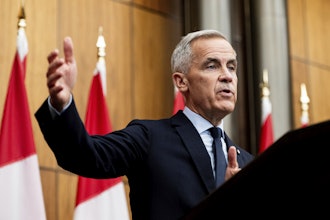This past December, Home Depot announced an ambitious plan to spend more than $11 billion to build out its “One Home Depot” customer experience and enhance everything from its stores, associates and online offering to its supply chain.
The home improvement retailer has now revealed details of that plan specifically for its distribution network, and they are significant.
Speaking at the Bernstein 34th Annual Strategic Decisions Conference May 31 in New York City, Home Depot chairman and CEO Craig Menear told a moderator that company plans to spend $1.2 billion over the next five years to build out a downstream distribution network.
That investment will include the addition of 170 distribution facilities across the U.S., which will enable Home Depot to offer same-day or next-day delivery for 90 percent of the U.S. population.
Menear broke down that 170 figure, detailing that Home Depot will build out 40 flatbed distribution centers to handle building material-type products that need to go direct to a job site for Pro customers. The company will build out approximately 100 market delivery operation centers for bulky customer items like patio products, grills and appliances direct through there to the customer through a delivery agent. The remaining ≈30 facilities will be local direct fulfillment centers that will handle a smaller subset of product that moves direct to customers. He added Home Depot will build out a couple more ‘parcel plus big direct fulfillment facilities’ that handle a mix of small products and bulk.
Menear acknowledged that, upon completion, the investment will enable Home Depot to offer the same shipping capabilities like that of Grainger, Fastenal and Amazon.
“Yes, the reason that we actually purchased and align brands was to get back in a subset of the MRO space that we felt was important to our business and that's multifamily, hospitality and institutional,” he said, referring to the company’s business additions in recent years. “We did not have the capabilities in the orange box business to be able to serve those customers the way we needed to do that, and delivery is an important element of that in terms of same day, next day.”
With its brick-and-mortar offering already in place, Home Depot boosted its MRO offering by enhancing its digital business and then made a major move by buying Jacksonville, FL-based Interline Brands — No. 14 on Industrial Distribution’s 2017 Big 50 List — in 2015 for $1.63 billion. Interline’s fiscal information hasn’t been shared since the acquisition, but it had 2014 sales of $1.7 billion and its website has stated the company is “approaching $2 billion in sales” since that time.
“So we have to merge all of that, and part of merging that is truly merging a One Home Depot supply chain so that we could be able to both fulfill for those MRO customers’ daily needs in terms of product for maintenance and repair but, at the same time be able to, if they need a water heater, a toilet or something from the stores, we will flow all of that together in one shipment to that customer in an expeditious fashion, and that's what we're building on in the supply chain,” Menear said.
Home Depot posted 2018 first quarter sales of $24.9 billion, up 4.4 percent year-over-year, while total profit of $2.4 billion increased from $2.0 of a year earlier. As of the end of Q1, Home Depot has approximately 2,280 stores company-wide.
The Wall Street Journal reported Tuesday that e-commerce accounted for only 6.7 percent of Home Depot’s 2017 full year sales, but that total digital sales jumped 21 percent from 2016.
The WSJ quoted Home Depot executive vice president of supply chain and product development, Mark Holifield, telling a logistics conference last week that, “Customers expect delivery to be free, they expect it to be timely. Sometimes they want it fast, and are willing to pay for that. Sometimes they want it free, and they’re willing to wait for it. We need to have the options right there.”
Holified reportedly outlined the same plan details with the conference that Menear did on May 31, adding, “This is part of an $11 billion overall plan to re-engineer our company to ensure that we are prepared for the future in retail.”






















